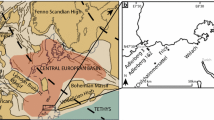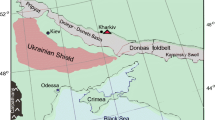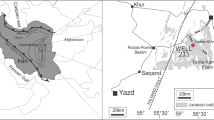Abstract
Palynological investigations have been completed in the Lower Carboniferous Kammquartzite Formation of the Hörre-Gommern-Zone, a long and narrow trench of diverging facies in the Kulm Basin in Germany. Due to the lack of macro- and microfauna and the different lithologies the stratigraphical position of the formation and also the palaeogeographical interpretation of the entire zone is discussed. Based on miospores, the Kammquartzite Formation has been dated for the first time.
Stratigraphical analysis of the spore assemblages shows that the formation ranges from the base of the Viséan (PU-Zone) to the Upper Viséan (ME-Zone). Because of the turbiditic nature of the quartzites, numerous reworked palynomorphs are preserved in the samples. The assemblages provide a good general view of Tournaisian (reworked) and Viséan (indigenous) microfloras in Germany. These are closely comparable to typical assemblages of W-Europe, but less diverse. The lack of strongly triangular genera is significant and problematic, because of their great stratigraphic value in the Upper Viséan elsewhere.
The palynofacies of the Kammquartzite Formation is compared to the palynofacies in the Kulm-Greywackes (major clastic facies of the Kulm Basin) and from Rügen Island (carbonate shelf). No significant change in palynofacies from Rügen (shelf facies) to the Kammquartzite Formation (basinclastics I) is observed, as would be predicted by common models in use. A strong difference in palynofacies is seen between the Kammquartzite Formation and the surrounding Kulm-Greywackes (basin clastics II). In addition to the petrographic evidence from the quartzites, palynofacies analysis clearly suggests that the source area of the Kammquartzite Formation is the Laurussian shelf north of the basin (Rügen) and is totally different from that of the Kulm-Greywackes.
Kurzfassung
Die unterkarbonische Kammquarzit-Formation wird palynologisch untersucht. Sie gehört zur Hörre-Gommern-Zone, einem schmalen, langgestreckten Sonderfaziesbereich im Rhenoherzynikum in Deutschland. Aufgrund des Fehlens von Makro- und Mikrofauna in der Formation sowie der stark abweichenden Lithologie wird sowohl die exakte stratigraphische Position der Formation als auch die paläogeographische Interpretation der gesamten Zone diskutiert. Anhand von Sporen kann die Kammquarzit-Formation nun erstmals feinstratigraphisch eingestuft werden. Demnach setzt die Kammquarzit-Formation an der Basis des Viséum (PU-Sporenzone) ein und reicht bis ins obere Viséum (ME-Sporenzone). Da es sich bei den Quarziten um Turbidite handelt, enthalten die Proben einen hohen Anteil an aufgearbeiteten Palynomorphen und geben damit einen guten Überblick über die Mikroflora sowohl des Tournaisium (aufgearbeitet) als auch des Viséum in Deutschland. Diese ist sehr gut mit der westeuropäischen Mikroflora vergleichbar, auch wenn die Diversität in der Kammquarzit-Formation deutlich geringer ist. Speziell stark dreieckige Formen sind sehr selten, was aufgrund ihrer großen stratigraphischen Bedeutung im oberen Viséum von Bedeutung ist.
Weiterhin wird die Palynofazies der Kammquarzit-Formation mit der Palynofazies der Kulm-Grauwacken (der dominierenden klastischen Fazies im Kulm-Becken) und der Palynofazies von Rügen (Karbonatschelf) verglichen. Entgegen bisherigen Modellen stimmen die Palynofazies von Rügen (Schelf) und der Kammquarzit-Formation (Beckenfazies 1) weitestgehend überein. Ein deutlicher Unterschied in der Palynofazies besteht dagegen zwischen Kammquarzit-Formation und den umgebenden Kulm-Grauwacken, den beiden Beckenfazies-Typen. Die Palynofazies-Analyse bestätigt damit die sedimentpetrographischen Untersuchungen, daß nämlich das Liefergebiet der Kammquarzit-Formation im Gegensatz zu den Kulm-Grauwacken auf dem nördlichen Schelf (Rügen) zu suchen ist.
Similar content being viewed by others
References
Bertelsen, F. (1972): A Lower Carboniferous microflora from the Ørslev No.1 borehole, Island of Falster, Denmark. — Danmarks Geol. Unders. II. Raekke,99: 1–78; Kopenhagen.
Bischoff, G. &Stoppel, D. (1957): Zum Alter des Wollenberg-Kellerwaldquarzits. — N. Jb. Geol. Paläont., Mh.,1: 14–24; Stuttgart.
Bohacova, M. (1963): (Palynological investigation of the Kounov seam in the Kladno-Rakovnik Basin). — Sbornik UUG,28: 185–231; Prag.
Büchner, K.-H. &Stoppel, D. (1997): Zur Geologie des Unterkarbons am Acker-Bruchberg (Harz) aufgrund von Kernbohrungen. — Z. geol. Wiss.,25 (3/4): 363–374; Berlin.
Burmann, G. (1975): Sporen aus dem Tournai von Rügen. — Z. geol. Wiss.,3: 875–905; Berlin.
Butterworth, M. A. &Williams, R. V. (1958): The small spore floras of coals in the Limestone Coal Group and the Upper Limestone of the Lower Carboniferous in Scotland. — Trans. Roy. Soc. Edinb.,63: 353–392; Edinburgh.
Butterworth, M. A., Jansonius, J., Smith, A. H. V. &Staplin, F. L. (1964):Densosporites (Berry)Potonié &Kremp and related genera. — C. R. 5. Congr. Avanc. Etud. Stratigr. Geol. Carb., Paris 1963;1: 1049–1058; Paris.
Carson, B. (1995): The palynostratigraphy, palynofacies and hydrocarbon source potential of the Lower Carboniferous in two boreholes from the Baltic island of Rügen, Germany. — 368 S., Dublin (Trinity College Dublin) [unpublished PhD Thesis].
Carson, B. &Clayton, G. (1997): The Dinantian (Lower Carboniferous) palynostratigraphy of Rügen, Northern Germany. — Proc. XIII Int. Congr. Carb. Perm.,1: 219–227; Warschau.
Clayton, G. (1985): Dinantian miospores and inter-continental correlation. — C. R. 10ème Congr. Stratigr. Géol. Carb.,4: 9–23; Madrid.
Clayton, G. (1996): Chapter 18 C: Mississippian miospores. — In:Jansonius, J. &McGregor, D.C. [Hrsg.], Palynology: Principles and Applications. — AASP Found., Vol.2: 589–596; Dallas.
Clayton, G., Higgs, K., Keegan, J. B. &Sevastupolo, G. D. (1978): Correlation of the palynological zonation of the Dinantian of the British Isles. — Palinologia, Num. Extraord.,1: 137–147; Leon.
Eder, W., Engel, W. &Uffenorde, H. (1969): Stratigraphische und fazielle Gliederung des Quarzit-Zuges im Kellerwald. — N. Jb. Geol. Paläont. Abh.,133 (3): 223–244; Stuttgart.
Engel, W., Franke, W., Grote, C., Weber, K., Ahrendt, H. &Eder, F.W. (1983): Nappe Tectonics in the Southeastern Part of the Rheinisches Schiefergebirge. — In:Martin, H. &Eder, F.W. [Hrsg.], Intracontinental Fold Belts. — 267–287; Berlin (Springer).
Franke, D. &Budzinski, H. (1970): Abschlußbericht über die Bearbeitung des Präperms der Bohrung E-Brandenburg 1E/Eh/68. — Z. Geol. Inst.: now Archiv des LGR Brandenburg; Berlin [unpublished].
Gothan, W. (1927): Das Alter der Tanner Grauwacke vom paläobotanischen Standpunkt aus. — Sitz. Ber. Preuß. Geol. L.-Anst.,2: 145–147; Berlin.
Hacquebard, P.A. (1957): Plant spores in coal from the Horton Group (Mississippian) of Nova Scotia. — Micropaleontology,3 (4): 301–324; New York.
Haverkamp; J., von Hoegen, J., Kramm, U. &Walter, R. (1992): Application of U-Pb-systems from detrital zircons for palaeogeographic reconstructions — a case-study from the Rhenohercynian. — Geodinamica Acta,5 (1–2): 69–82; Paris.
Jäger, H. (1998): Lower Carboniferous miospores from Germany. New palynological investigations in the Kulm Basin and from the Baltic Island of Rügen. — CIMP Symp. and Workshop, Abstr. Vol.: 41; Pisa.
Jäger, H. (1999): Sedimentologie und Biostratigraphie (Palynostratigraphie) der unterkarbonischen Quarzitfolge der Hörre-Gommern-Zone im Rhenoherzynikum. — Diss., 178 S.; Darmstadt.
Jäger, H. (in press): Kap. 3.3 Mikroflora. — In:Stoppel, D. [Hrsg.], Das Unterkarbon (Dinant) in Deutschland. — Cour. Forsch. Senckenberg, 17 S., 8 Abb., 2 Taf.; Frankfurt a. M.
Jäger, H. &Gursky, H.-J (2000): Alter, Genese und Paläogeographie der Kammquarzit-Formation (Visé) im Rhenoherzynikum — neue Daten und neue Deutungen. — Z. dt. geol. Ges., 151,4: 415–439; Stuttgart.
Kedo, G. I. (1963): Spores of the Tournaisian stage of the Pripyat Depression and their stratigraphical significance. — Rep. Paläont. Strat. B.S.S.R.,4: 3–121; Minsk.
Kmiecik, H. (1986): Palynostratigraphy of the Carboniferous at the margin of the Polish part of the East-European Platform. — Rev. Palaeobot. Palynol.,48: 327–345; Amsterdam.
Love, L. G. (1960): Assemblages of small spores from the Lower Oil-Shale Group of Scotland. — Proc. Roy. Soc. Edinburgh,67 (2): 99–126; Edinburgh.
McPhilemy, B. (1989): Palynology and Palynofacies of some Lower Carboniferous sections in Northwest Ireland. — 185 p.; Dublin (Trinity College Dublin) [unpublished PhD Thesis].
Meischner, D. (1991): Kleine Geologie des Kellerwaldes. — Jber. Mitt. oberrhein. geol. Ver., N.F.73: 115–142; Stuttgart.
Paech, H.-J. (1973): Zur Geologie des Gommern-Quarzits östlich Magdeburg. — Z. geol. Wiss.,1: 815–830; Berlin.
Potonié, R. (1958): Synopsis. Teil II: Sporites (Nachträge), Saccites, Aletes, Praecolpates, Polyplicates, Monocolpates. — Beih. Geol. Jb.,31: 1–114; Hannover.
Ravn, R.L. (1991): Miospores of the Kekiktuk Formation (Lower Carboniferous), Endicott Field Area, Alaska North Slope. — AASP Contributions Series,27: 173 pp.; Dallas.
Schriel, W. &Stoppel, D. (1958): Acker-Bruchberg und Kellerwald — Stratigraphie und Tektonik. — Z. dt. geol. Ges.,110: 260–292; Hannover.
Schwan, W. (1958): Zur Neugliederung der Acker-Bruchbergschichten nach Conodonten, speziell bei Bad Harzburg. — Geologie,8: 991–1017; Berlin.
Schwan, W. (1967): Zur Stratigraphie, Paläogeographie und der Faziesbildung der Hörre-, Gommern- und Tanner-Systeme. — Erlanger geol. Abh.,65: 70 pp.; Erlangen.
Schwan, W. (1991): Geologie des Acker-Bruchberg-Ilsenburg Zuges (Oberharz). — Derzeitiger Forschungsstand und Diskussion der Probleme. — Zbl. Geol. Paläont. Teil I,7: 787–850; Stuttgart.
Smith, A. H. V. &Butterworth, M. A. (1967): Miospores in coal seams of the Carboniferous of Great Britain. — Spec. Papers in Pal.,1: 1–324; London.
Somers, Y. (1972): Révision du genreLycospora Schopf, Wilson & Bentall. — In:Alpern & Neves [Hrsg.], Les Spores. — Microfoss. Organ. Paleoz.,5: 1–110; Paris.
Trautnitz, H.M. (1980): Zirkonstratigraphie nach vergleichender morphologischer Analyse und statistischen Rechenverfahren. — 159 pp.; Erlangen [unpublished Diss.].
Turnau, E., Avchimovitch, V. I., Bysheva, T. V., Carson, B., Clayton, G. &Owens, B. (1997): The first appearance in Europe ofLycospora pusilla (Ibrahim) Somers and its relationship to the Tournaisian/Visean boundary. — Proc. XIII Int. Congr. Carb. Perm.,1: 289–293; Warschau.
Walliser, O.H. &Alberti, H. (1983): Flysch, olisthostromes and nappes in the Harz mountains. — In:Martin, H. &Eder, F.W. [Hrsg], Intracontinental fold belts: 145–169; Heidelberg [Springer].
Wierich, F. &Vogt, A. (1997): Zur Verbreitung, Biostratigraphie und Petrographie unterkarbonischer Sandsteine des Hörre-Gommern-Zuges im östlichen Rhenoherzynikum. — Geologica et Palaeontologica,31: 97–142; Marburg.
Württemberger, G. (1865): Der Kulm oder die untere Steinkohlenformation in Hessen. — N. Jb. Min.,1865: 530–575; Stuttgart.
Zakowa, H.,Kmiecik, H.,Kotasowa, A.,Migier, T.,Musial, L.,Siewniak-Madej, A.,Sobon-Podgorska, J.,Tabor, M. &Tomas, A. (1995): Correlation of stratigraphic results. — In:Zdanowski, A. &Zakowa, H. [Hrsg.], The Carboniferous system in Poland. — Pac. Pánst.Inst. Geol.,CXLVIII: 215 pp.; Warschau.
Author information
Authors and Affiliations
Rights and permissions
About this article
Cite this article
Jäger, H. Palynology of the lower carboniferous (Mississippian) kammquartzite formation in the rhenohercynian zone, Germany. Senckenbergiana lethaea 82, 609–637 (2002). https://doi.org/10.1007/BF03042953
Received:
Accepted:
Issue Date:
DOI: https://doi.org/10.1007/BF03042953




